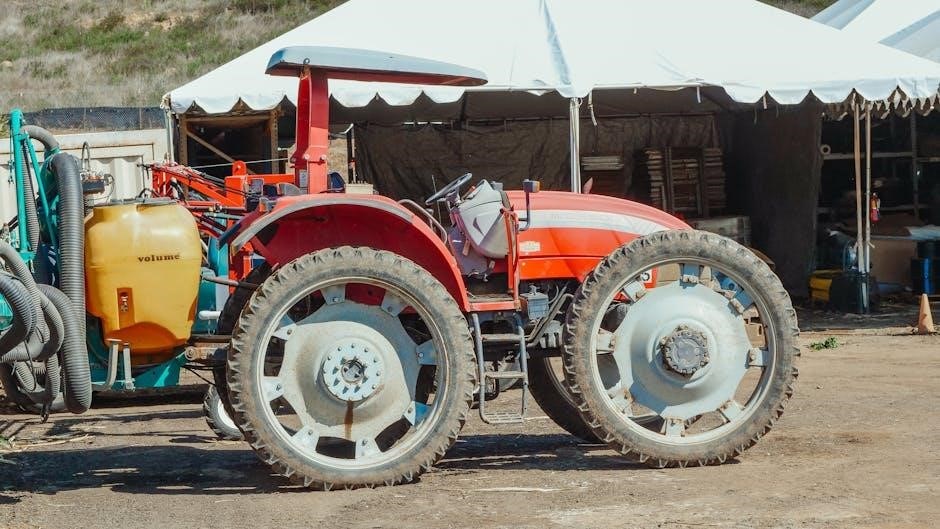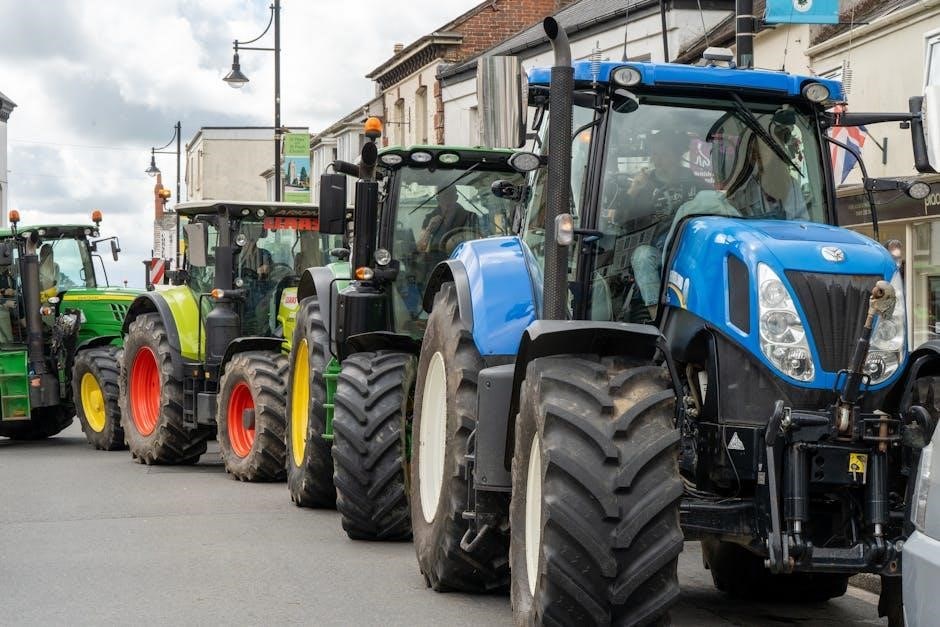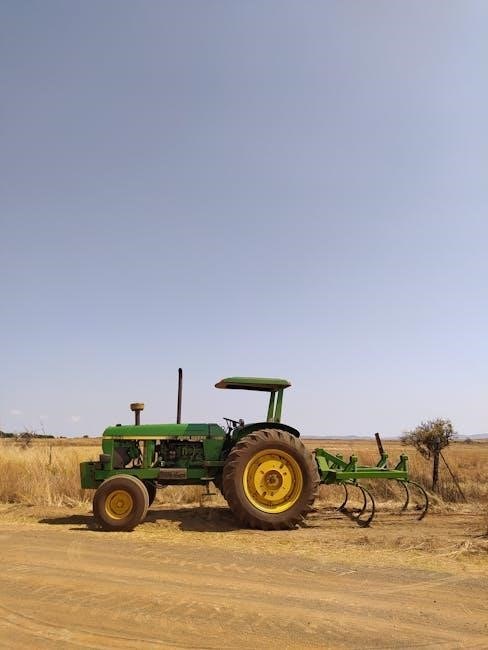Understanding tractor tire sizes is crucial for optimal performance and safety. This guide helps you decode the complexities of tire measurements and choose the right fit for your needs.
Understanding the Importance of Proper Tire Size
Proper tractor tire size is essential for optimal performance, safety, and efficiency. Incorrectly sized tires can lead to reduced traction, compromised stability, and increased risk of accidents such as rollovers. They must support the tractor’s weight and any additional loads, ensuring safe operation across various terrains. Proper sizing also prevents soil compaction, maintains fuel efficiency, and ensures the tractor’s overall productivity. The right tire size is crucial for balancing safety, efficiency, and soil preservation, making it a fundamental aspect of tractor maintenance and operation.

Components of Tractor Tire Size
Tractor tire sizes include section width, rim diameter, farming tire series, and casing type. These components ensure proper fitment, load capacity, and traction for specific applications.
Section Width and Rim Diameter
The section width of a tractor tire refers to the distance between the two sidewalls when the tire is properly inflated and mounted on the rim. The rim diameter, measured across the center of the wheel, indicates the size of the wheel the tire is designed to fit. Together, these measurements ensure the tire is correctly matched to the tractor’s wheels for optimal performance and safety. Accurate measurements are essential to avoid improper fitment, which can lead to reduced traction, uneven wear, or compromised stability.
Farming Tire Series and Casing Type
The farming tire series refers to the tread pattern and design, such as R1, R2, R3, and R4, each suited for specific agricultural tasks. The casing type indicates the tire’s construction, like radial or bias-ply, affecting durability and load capacity. Understanding these elements ensures proper traction, soil protection, and machine performance. For example, R1 tires are ideal for general farming, while R4 tires are designed for industrial use. Selecting the right series and casing type ensures optimal performance, safety, and longevity for your tractor’s tires, tailored to the demands of your farming operations and terrain conditions.

Reading Tractor Tire Sidewall Markings
Reading tractor tire sidewall markings is essential for identifying size, tread type, and load capacity. Proper interpretation ensures the right fit and optimal performance for your tractor.
Deciphering the Sidewall Nomenclature
Tractor tire sidewalls feature a series of codes and numbers that provide critical information. The size is typically represented by two numbers, indicating section width and rim diameter. Additional markings include the tire series, casing type, and load index, which denote strength and capacity. Some tires also display tread patterns, such as R1 for agricultural use. Properly decoding these markings ensures compatibility with your tractor and optimal performance for specific tasks. Always refer to the sidewall nomenclature when selecting or replacing tires to maintain safety and efficiency.

Why Tire Size Matters
Proper tire size ensures optimal tractor performance, safety, and efficiency. Incorrect sizes can lead to reduced stability, compromised traction, and inefficient power delivery, affecting overall productivity and operational safety.
Impact on Tractor Performance and Safety
Proper tractor tire size significantly impacts performance and safety. Incorrect sizes can lead to poor traction, reduced stability, and inefficient power delivery. Tires that are too small or too large may cause uneven wear, compromising handling and increasing the risk of accidents. Additionally, mismatched tires can affect braking efficiency and overall control, especially on uneven terrain. Safety risks like rollovers and loss of control are heightened with improperly sized tires. Ensuring the right fit is essential for maintaining optimal performance, operational efficiency, and most importantly, the safety of the operator and equipment.

Measuring Tractor Tires
Measure section width and diameter accurately using a tape measure. Ensure the tire is properly inflated and measure across the tread width and rim diameter for precise fit.
How to Accurately Measure Section Width and Diameter
To measure tractor tires, start by ensuring the tire is inflated to the recommended pressure. Measure the section width across the widest part of the tread using a tape measure. For diameter, measure from the ground to the top of the tire at the centerline. Use a straight edge or caliper for precise rim diameter measurements. Double-check the sidewall markings to confirm the specifications. Accurate measurements ensure proper fit and performance, avoiding issues with traction and stability.
Selecting the Right Tire Size
Choosing the correct tractor tire size involves matching the tire’s specifications to your tractor’s requirements, considering intended use, terrain, and load capacity for optimal performance and safety.
Considerations for Intended Use and Terrain
When selecting tractor tires, consider the intended use and terrain. For heavy-duty farming, larger tires with deeper treads like R1 (agricultural) or R2 (soil-friendly) are ideal. Softer soils may require R2 tires to minimize compaction, while R3 tires are better for industrial or heavy loads. For mixed use, R4 tires offer a balance between road and field performance. Always match the tire size and tread pattern to the specific terrain and job requirements to ensure optimal traction, stability, and soil protection. Proper selection enhances productivity and safety in various working conditions.
Standard vs. Metric Tire Sizes
Standard tire sizes use inches for rim diameter, while metric sizes use millimeters. Both systems are precise, but regional preferences often dictate which is used. Matching your tractor’s specifications is crucial for compatibility and performance.
Understanding the Differences and Conversions
Standard tire sizes use inches for rim diameter, while metric sizes use millimeters. For example, a 12.4-24 standard tire converts to 315/80R24 in metric. To convert, multiply the inch measurement by 25.4. This ensures compatibility and precise fitment. Understanding these differences is essential for matching tires to rims and maintaining tractor performance. Proper conversions prevent sizing errors and guarantee safety. Always refer to manufacturer guidelines for accurate measurements and conversions to avoid mismatches and potential operational issues.
Ballasting Tractor Tires
Ballasting enhances tractor tire performance by adding weight, often water or liquid, to improve traction and stability. This method is crucial for heavy-duty farming operations and preventing slippage.
Methods and Benefits for Enhanced Performance
Ballasting tractor tires involves adding weight, typically through water or liquid solutions, to improve stability and traction. Water ballasting is the most common method, enhancing grip on slippery surfaces. Liquid ballast, like calcium chloride, offers additional weight without excessive water. Proper ballasting reduces soil compaction, improves load distribution, and lowers the center of gravity, minimizing rollover risks. It’s especially beneficial for heavy-duty farming, ensuring efficient operation and safety. Regular monitoring and maintenance are essential to avoid over-ballasting, which can damage tires or hinder performance.
Environmental Impact of Tractor Tires
Tractor tires release petrochemicals, rubber compounds, and heavy metals like mercury and lead into soil and groundwater, posing long-term ecological risks. Eco-friendly disposal methods are essential.
Eco-Friendly Considerations and Disposal
Proper disposal of tractor tires is critical to prevent environmental contamination. Old tires release harmful chemicals like mercury and lead into soil and water. Recycling or repurposing tires reduces ecological damage. Eco-friendly manufacturing processes and sustainable materials are increasingly adopted to minimize environmental impact. Regular maintenance and responsible tire replacement also contribute to reducing waste. Ensuring tires are disposed of through approved facilities or recycling programs helps protect the environment and promotes greener agricultural practices.
Selecting the right tractor tire size is crucial for optimal performance, safety, and environmental sustainability. This guide provides essential insights to help you make informed decisions;
Summarizing Key Points for Optimal Tire Selection
Understanding tractor tire size components, such as section width and rim diameter, is essential for proper fitment. Accurate measurements ensure compatibility with your tractor’s rims. Consider the intended use and terrain to choose the right tread pattern and tire type. Ballasting can enhance stability, while eco-friendly options reduce environmental impact. Always refer to sidewall markings for precise sizing and load ratings. By aligning these factors with your needs, you can optimize performance, safety, and efficiency, ensuring your tractor operates at its best in all conditions.



